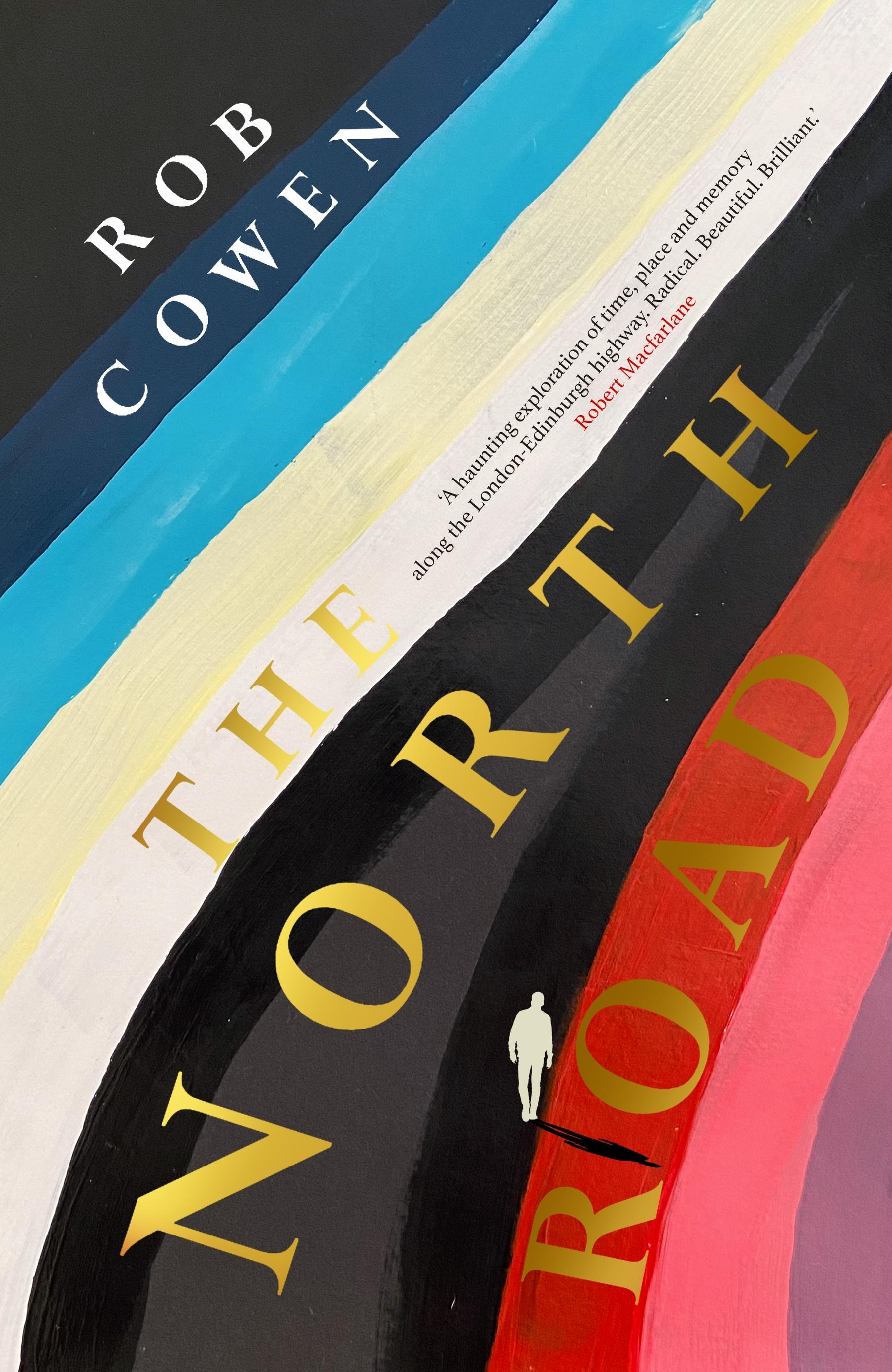

The North Road
‘Haunted and haunting: Cowen tracks the London−Edinburgh highway in a mesmerising exploration of time, place, memory and identity. A dazzlingly inventive work of literature.’
Robert Macfarlane
‘In combining deep history, travel, memoir, fiction and so much more besides, Rob Cowen has created something stunning and utterly unique. The North Road sits in a genre of one. He’s a wandering wizard, a magician whose brilliance lies not in trickery, but in real talent and a wild, untamed imagination that’s capable of transcending time.’
Benjamin Myers
‘The North Road is stunning, weaving an intricate tapestry of tarmac, humanity and time, as rich as the dark earth on which his many threads lie. It will stay with me.’
Raynor Winn
‘When I began this book, I wondered if it would be for me. I didn’t think I was interested in roads. But The North Road is a wonderful, epic braiding of history, geography and personal memoir. It made me think deeply about who we are, and where we came from; our country in this moment in time, and how we can learn from our past. I couldn’t put it down.’
James Rebanks
‘A dazzling, dogged, layered account of one road’s passage through place, time and an ordinary family’s history, The North Road truly is a trip.’
Melissa Harrison
‘Epic, magisterial, hard-won, properly-wrought − much like the Great North Road itself. Truly, a tour de force . . . you may read another book in 2025, you will not read a better one.’
John Lewis-Stempel
‘Masterful. One of the best books I’ve read in a long time.’
John Mitchinson
‘This book will have you tripping on England. Rob Cowen has made the great portrait of the A1, “the main road” par excellence. His text is a glimmering cocktail of memory and diachronic history, a plait of three enchanted cords − the ancient highway itself, the life of the land, and Cowen’s personal story.’
Damian Le Bas
‘A deep and richly satisfying, mind-bending exploration of space, place and memory. I loved the many, many colourful layers of The North Road.’
Clover Stroud
‘A masterful weaving of time and place. The North Road offers a rare, strong blend of national and personal − sweeping, sensitive and enduring.’
Tristan Gooley
‘A road, like a story, is never just that. Both have roots, tributaries, ancestors and consequences. From first step to surprise destination, The North Road is as layered and braided as the route it follows, and as brutal, beautiful and unique as a life. With his singular blend of research, personal exploration and intensely visceral storytelling, Rob Cowen is truly in a class of his own.’
Amy-Jane Beer
‘Rob Cowen brings a highway to living sentient life, from nowhere to everywhere in this elegant, moving mind-map of a storied road.’
Philip Hoare
‘Rob Cowen is an enchanter, and he has conjured up a classic with this extraordinary, multi-layered knockout of a book. The North Road asks all the big questions – identity, history, memory, belonging – and offers riffs and responses that are both personal and universal, never glib, always beguiling.’
Dr Sharon Blackie
‘Rob Cowen’s account of a journey on foot fragments − startlingly − into history, fiction, philosophical enquiry and fearless memoir.
A beautifully woven and mesmerising book.’
Tom Bullough
‘Rob Cowen weighs up the mighty A1 from the hard-packed solum beneath its pitch to the aerial maps by which so many steer its course. The North Road is by turns brilliant, questing and poignant. Equal parts ardent asphalt anthem and song to belonging, Cowen’s new book is a north/south tour de force.’
Dan Richards
‘I loved the combination of memoir, history, family story, the vivid fictional interludes. All the familiar places referenced along Rob Cowen’s journey made The North Road feel universal; many will get a similar resonance from it as I did. Rob has given the A1 an entirely new sense of life.’
Luke Turner
‘An extraordinary, beautifully realised road trip. Here, a road is a tributaried river, created and recreated by ourselves, our ghosts, doubles and echoes, and told as the story of us in the connections and coincidences a road engenders. This poetic, poignant and lyrically political book throws up more mysteries than it answers, as the best literature does, and leaves us wanting more.’
Nicola Chester
‘This thought-provoking and beautiful exploration of that most humanised of spaces, the road, shows how our lives are always intimately bound to those of others within the social landscape. Through sharing and celebrating this common journey, Cowen manages to demonstrate the wonder of what it is to be alive. This is a book that will have your heart ringing like a bell.’
Matt Gaw
‘Through Cowen’s engrossing, original narrative, this Roman road proves to be anything but straightforward. In revealing buried pasts, glancing the uncanny, and exhuming the strata of both personal and national identity, Cowen explores the question of our final destination: What will remain? Reading this is a revelation.’
Jade Angeles Fitton
‘The North Road utterly took my breath away. This genre-bending book is both lyrical and gritty, blending fiction and non-fiction. It signifies literal and metaphorical journeys: of personal evolution, the movement through time, freedom and escape, the unpredictability of life, breaking societal constraints, and connecting people, places, and ideas. Deeply researched and exquisitely poetic.’
Kathryn Aalto
‘Full of unexpected diversions and detours − just like the great road itself − Rob Cowen’s The North Road takes us on a fascinating, multi-layered journey through history, place, and personal story. Brilliantly researched, beautifully written, profound, and utterly unique.’
Brigit Strawbridge Howard
Also
by Rob Cowen
Non-fiction
Common Ground
Skimming Stones
Poetry
The Heeding
Rob Cowen
The North Road

Hutchinson Heinemann
Penguin Random House
One Embassy Gardens
8 Viaduct Gardens
Nine Elms
London SW 11 7BW
Hutchinson Heinemann is part of the Penguin Random House group of companies whose addresses can be found at global.penguinrandomhouse.com.
Copyright © 2025 Rob Cowen
Rob Cowen has asserted his right to be identified as the author of this Work in accordance with the Copyright, Designs and Patents Act 1988.
First published by Hutchinson Heinemann in 2025
Penguin Random House values and supports copyright. Copyright fuels creativity, encourages diverse voices, promotes freedom of expression and supports a vibrant culture. Thank you for purchasing an authorised edition of this book and for respecting intellectual property laws by not reproducing, scanning or distributing any part of it by any means without permission. You are supporting authors and enabling Penguin Random House to continue to publish books for everyone. No part of this book may be used or reproduced in any manner for the purpose of training artificial intelligence technologies or systems. In accordance with Article 4(3) of the DSM Directive 2019/790, Penguin Random House expressly reserves this work from the text and data mining exception.
www.penguin.co.uk
A CIP catalogue record for this book is available from the British Library.
ISBN 9781529152432
Map © Darren Bennett at DKB Creative Ltd
Typeset in 10.5/14pt Sabon LT Std by Jouve (UK), Milton Keynes Printed and bound in Great Britain by Clays Ltd, Elcograf S.p.A.
The authorised representative in the EEA is Penguin Random House Ireland, Morrison Chambers, 32 Nassau Street, Dublin D 02 YH 68
www.greenpenguin.co.uk
Penguin Random Hous e is committed to a sustainable future for our business , our readers and our planet. is book is made from Forest Stewardship Council® certified paper.
For Mum, Dad and all who’ve travelled with me. And for Rosie, Tom and Bea: my road ahead.

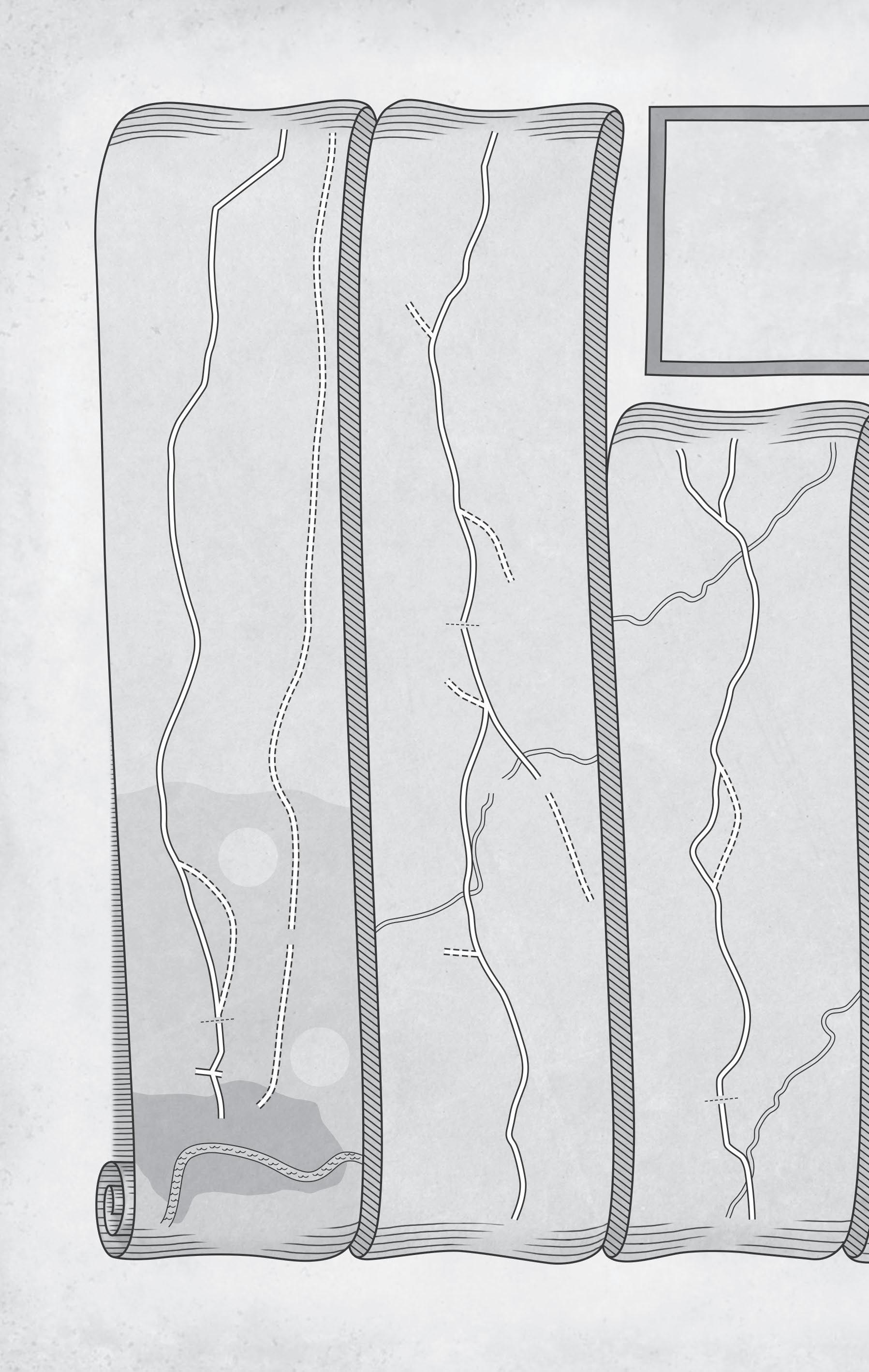

























































Bishop Auckland Spennymoor
Bishop Auckland Darlington Spennymoor




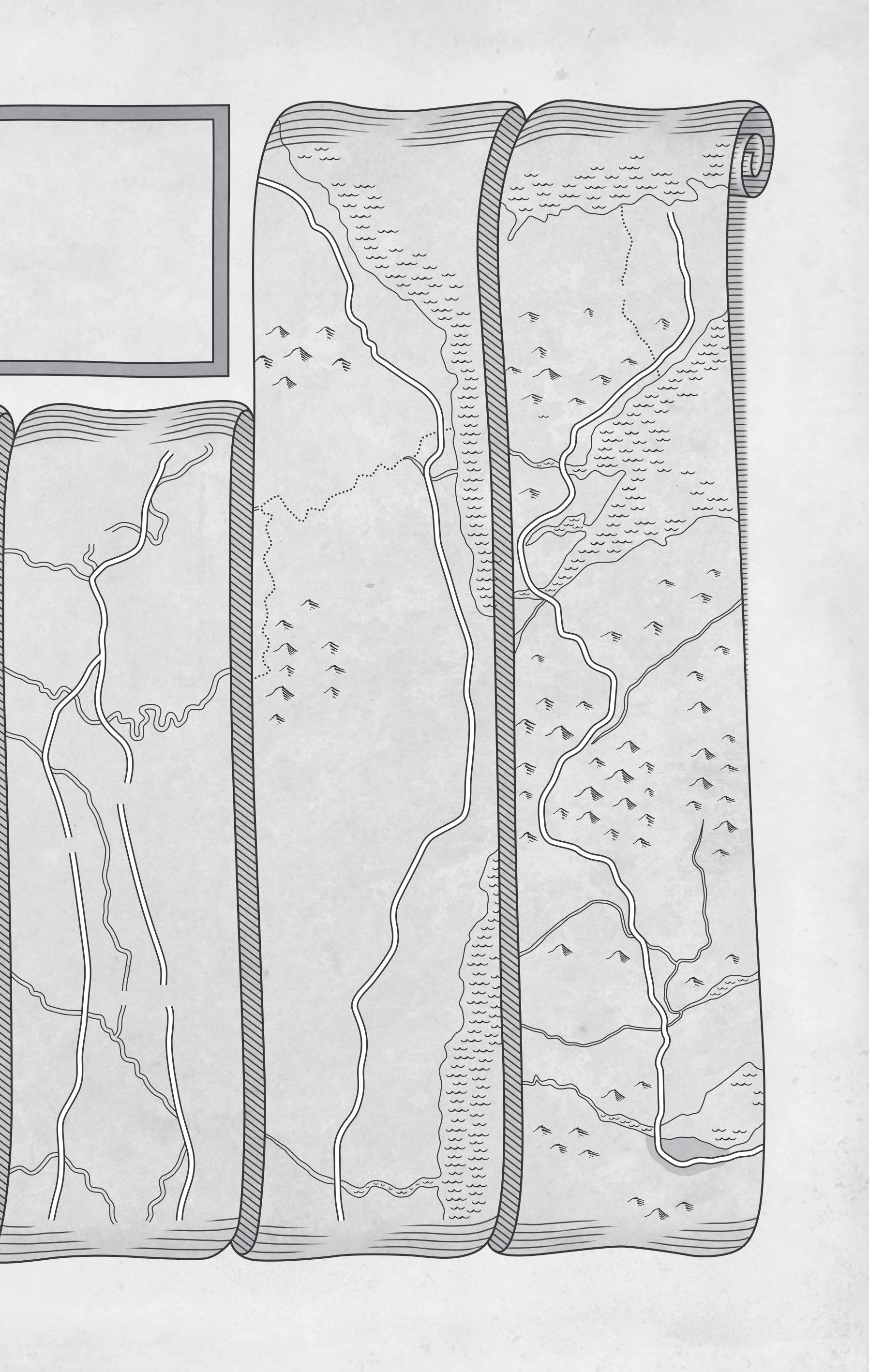
Catterick




























I. Ghost Road
II. Open Road
III. Road Home
I Ghost Road
I love roads: The goddesses that dwell Far along invisible Are my favourite gods. Roads go on While we forget, and are Forgotten like a star That shoots and is gone.
Edward Thomas
Every life is in many days, day after day. We walk through ourselves, meeting robbers, ghosts, giants, old men, young men, wives, widows, brothers-in-love, but always meeting ourselves.
James Joyce
Surfacing (Catterick)
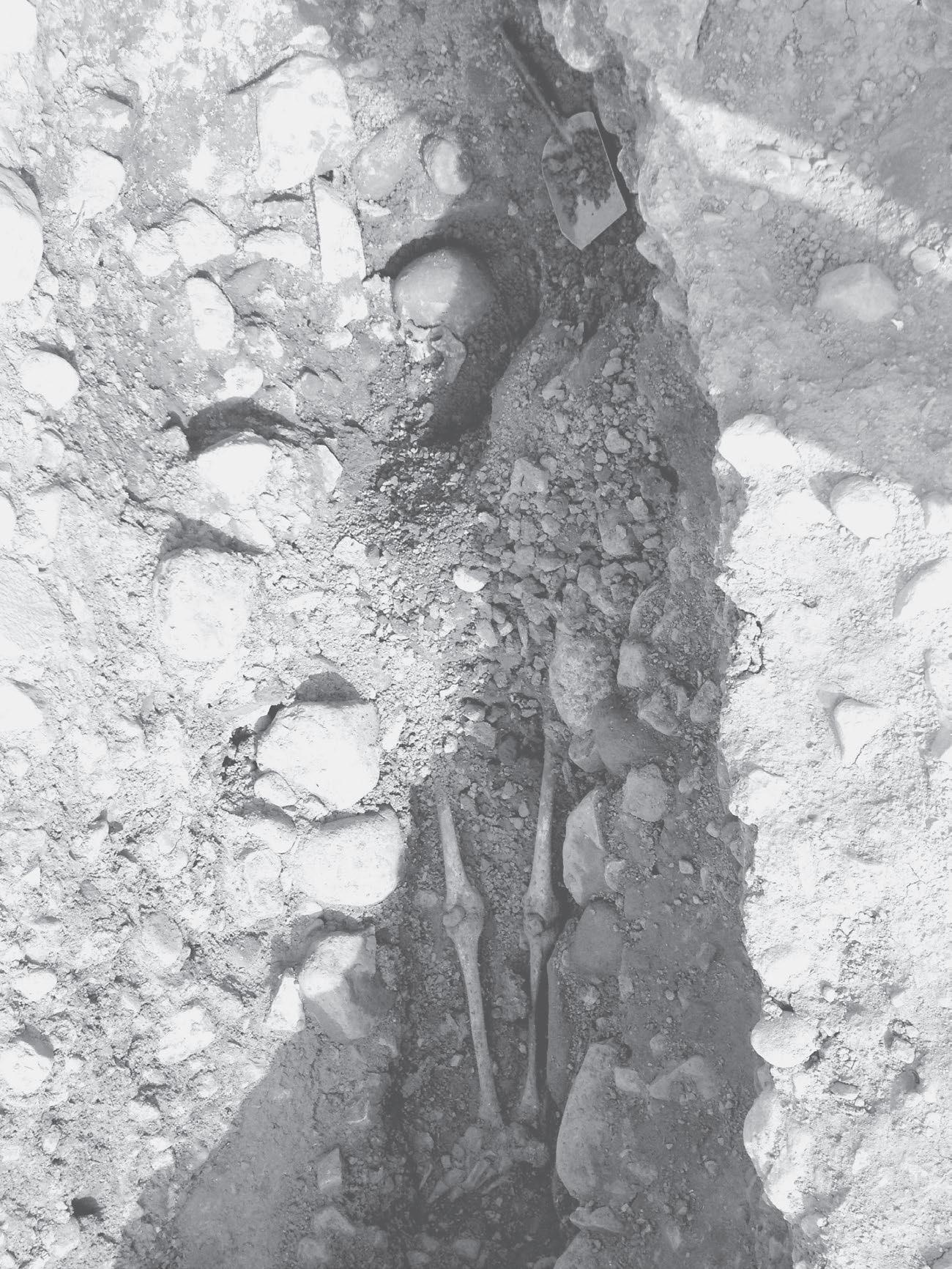
IThere were ten of us that morning kneeling by the road, searching for the dead. Ten of us in neon jackets and hard hats, digging out those womb-like hollows in the dirt, bringing into the light that which had long lain buried. And what light it was. Bright and sharp. Northern England on the cusp of May. It had been a bitter spring of late snows but at last the land seemed to be yielding again. You could sense it in every scrape of the soil: the earth stirred and stirring, the ground giving up its ghosts.
I was being careful. Careful not to appear too inexperienced; careful to hold the trowel exactly as I’d been shown, dragging the earth towards me in short, quick strokes. This was new territory for me and it felt a little like one of those anxiety dreams where you suddenly find yourself at the controls of a plane with no idea how to fly or being ushered into a surgical theatre, dressed in scrubs and gloves, expected to operate on a waiting body. Except the body here was a large sweep of roadside field, freshly scalped by a mechanical excavator. Gone the topsoil, the skin of the land; gone the thick flush of spring grass; gone the young crops and the hedges. What remained was the hard-packed substrate a metre or so down – that which is known in archaeological circles as the horizon. What this horizon was exposing was what had lain undisturbed for God knows how long. But with the sun spilling over the soil, severed roots and stones it shone wetly, in the way of a new wound. The way an estuary does when the tide is out.
I scraped and I stared. This was the operation – scraping and staring at the earth. Actually, less at the earth. More into the earth, because that’s the first thing you need to learn. To train yourself to look in a different way, to shift focus and see beyond the surface of things.
Digging is an exercise in awareness as much as moving matter. It requires you to be alive to the smallest changes in colour, texture or material, to recognise and read the irregularities and uneven edges. Each sweep of the trowel is like a summoning spell and, in between, you’re scouring for the tiniest indications of the magic working. Sifting and sorting, you’re scanning constantly for any suggestion of human hand or human remains, waiting for the moment when brain and eye align and things transform before you. Pebble into potshard. Soil and stone into spoil and bone.
The man overseeing me was called Jan. He was from Eastern Europe and had come to Yorkshire for the job, part of a community of archaeologists and diggers that move from site to site. ‘Following the work’, as he put it, and this was good work. A major road scheme. It was Jan who’d met me at the edge of the horizon and given me the once-over, clocking my hesitation, my notebook and the cheap trowel I was carrying. In a world where a well-worn edge earned through years of use is a badge of honour, a plastic-handled builder’s trowel found at the back of a shed turns out to be a giveaway. To his credit, he had taken me under his wing, giving me a crash course in wielding the blade, before walking me over to the patch of ground he was working on. He’d explained that pressure and balance were key. ‘Not firm. Not soft.’ It was about scraping and clearing away the surveyed soil with a shovel and bucket as you went along. Then, once we’d reached the grave cut – a depression of darker soil edged with stones – he’d shown me what he meant. There was a rhythm to it, which I picked up quickly, although I suspect you could overthink such things. As I carefully tried to follow instructions, Jan leaned over me and hacked at a piece of dirt with something pulled from his top pocket. It took me a second or two to realise it was a dessert spoon.
The light, the earth stirred and stirring, Jan and his spoon, and me – scraping, staring, trying not to look too conspicuous. That’s what I remember of that first surreal hour or so on-site. How, with my eyes down in concentration, everything seemed to fall away. How the world narrowed to the horizon beneath and all sound was drowned in the hypnotic, sea-on-shingle roar of the road. How thoughts that had swirled around my head for months escaped me,
and others slipped in unexpectedly. How it was hard not to lose track of time and how, after a while, I must have done because when I sat up to wipe the sweat from my face, the day’s brightness seemed to have intensified, the scrape had deepened and it no longer seemed so strange to be there. Another digger – a woman with shock-pink hair – stretched her back. She caught my gaze, then gestured at the ground. I knew what she was asking: Have you found anything yet? I shook my head. She flashed the thumbs-up. You will, she was saying. You will.
Ten of us kneeling by the road, searching for the dead. When I’d woken that morning and assumed the same position on the bedroom floor to change my daughter’s nappy, this wasn’t how I’d imagined the day unfolding. But sometimes these things happen. New horizons emerge and beckon. You chance upon a door and a crack of light and before you know what you’re doing, you’re pushing through to the other side.
It was my dad’s idea to join the dig. I’d been feeling out of sorts for a while, ever since finishing writing a book and closing the cover on three years of life. Riding out the bump and crash that followed had been tough-going. The intensity of those final frenzied weeks compounded by the sheer exhilaration and exhaustion of becoming a father again. Only a few days after handing the manuscript in, our little girl, Beatrice, Bea, arrived like a flaming torch into that freezing January, a force of nature from the second she lit up the birthing ward with a wild cry. I’ve always been suspicious of claims about such things, but I swear she was born with her personality fully formed. Who she was, who she would be – there from the off. Her radiance, her defiance, her raging, irrepressible independence. Carrying her home wrapped in blankets to meet her brother, Thomas, had been like bringing in glowing coals. Our house immediately felt different. But, like a fire, you couldn’t take your eyes off her for long. Perhaps understandably, she wanted to be held all the time and was resolute that she would only sleep in her mother’s arms. My wife, Rosie, bore the brunt of it, but within a month we were both dead on
our feet. There were things to be done at every turn: piles of washing and dirty dishes, nappies to change, and always someone to be bathed, fed, held, helped or coaxed out of a crying fit. With two children now, there was no escape for either of us any more. As any parent knows, newborns and toddlers exist entirely in the present and it quickly became clear that we would need to do the same. For a while, at least. Time slipped and snagged. A minute might catch on a moment and stretch into an hour; a day could vanish in what seemed seconds. Our universe shrank to the immediate and the essential, which made focusing on anything beyond the walls and windows of the house impossible. This presented a problem, though. The book was done and we needed money.
I searched out jobs and took writing commissions but I found that for the first time in my life the words weren’t coming. Weeks passed sitting in the library staring at my laptop screen, chasing half-thoughts down dead ends, going all kinds of nowhere at once. Forcing myself to finish a page felt like learning to write again. It was less a block, more that the tank was empty. In rational moments I could convince myself it was temporary; that such phases are just part and parcel of finishing any long slog of work, but in truth it made me feel edgy and anxious, then guilty and frustrated that time was passing and I was neither helping at home nor seemingly able to bring any money in. This dragged on, all through the end of that bitter winter, into the frigid spring. Sleepwalking through days, then wide awake in the wee hours, worrying, trying to get Bea to settle for long enough to give Rosie the unbroken rest she so desperately needed. An hour or two. Three at the most. Some nights, with all ideas and internet-researched tips exhausted, I’d give up on sleep, carry Bea to the window, hug her close for warmth and wait for morning – the frozen world through the glass dulled and distant in the dark, like I was remembering it from a dream.
The road came out of nowhere. One afternoon in early April, Dad had called in on his way past from somewhere further north. While Rosie and Bea slept, we drank coffee and talked things over, helping Tom push toy cars around his favourite play mat, printed with a cartoon map of lush green fields, woods and wide, empty roads. Dad had been due earlier, but he’d been caught in traffic. Highways
England was working on or, in the wording of such things, ‘improving and upgrading’ twelve miles of the A1 not far from our home. The scheme involved transforming a long stretch of dual carriageway into motorway-grade six-lane, renaming it the A1(M) – part of a gradual modernising that had been happening up and down this old highway for years. The delay hadn’t bothered Dad, though. If anything, he was excited to have been caught up in it all. As a member of YAHS – the Yorkshire Archaeological and Historical Society – he was privy to news filtering out from the archaeologists working ahead of, and alongside, the bulldozers – the teams tasked with surveying, recording and rescuing everything that would otherwise be buried under layers of tarmac. What they were unearthing was astonishing: flint hoards and post-holes from Mesolithic shelters; Neolithic pottery and hand axes; Iron Age settlements; thousands of Roman, Saxon and Anglian finds. In one old roadside house ear-marked to be knocked down, they had uncovered the ghost walls of a forgotten eighteenth-century coaching inn, itself built upon the bones of a medieval farmhouse.
I knew the road, of course. This was the A1 after all. Alpha One. Britain’s primary road – a 400-mile arterial link running between London and Edinburgh like a backbone through the country. I knew too that the cipher ‘A1’ was only one of this highway’s many incarnations, bestowed on what was previously the Great North Road during a nationwide road-numbering scheme in the years after the First World War. It is a rebrand that has never fully taken. Even a century on, the name ‘Great North Road’ frequently follows any mention of its successor, like a clarification. As though the speaker is divulging a truer identity: the A1 . . . the Great North Road. For various reasons, it’s also the road I’ve travelled more than any other. I’ve never lived further than fifteen miles away from it. For six years my home was a tiny flat along one of its early stretches in London. Still, I’d be lying if I said I’d ever given it too much thought. Whenever encountering it, I found its muddle of identities and variants confusing. For all the romance of its old name, the promise of return it held for a northerner relocated to the capital, it still appeared like any modern highway: noisy, poisonous, devoid of life. Off-limits unless you were in a vehicle, whereupon it blurred into an amnesia-inducing
non-place. Somewhere to be endured, transcended, en route to anywhere else.
Listening to Dad, though, it was hard not to think again. To think differently. Hard not to be a little curious and intrigued. Here was his idea: Why didn’t I try to get on-site? Perhaps I could write about the excavations for a newspaper? Make some money? Either way, it would do me good, he suggested, to be proactive; to shake the listlessness and feel a new season on the skin. He had a contact if I was interested. Someone who could put me in touch with someone.
That evening, as I packed away Tom’s toy cars and rolled up his play mat’s cartoon vision of countryside, I mulled over what Dad had said, wondering about the hidden worlds beneath, between, beyond our own. I thought about how much we miss and how partially sighted we become, caught in the chaos of our own little universes. You could go, I thought. Follow the road awhile. See where it leads. Besides, it would only mean a day away from home. Not too long to abandon Rosie and the kids.
I was awake before the alarm on the day of the dig, moving on autopilot, changing Bea beside our bed. As she fed in Rosie’s arms, I showered and pulled on my clothes. It was too early, I knew that, but it had been made clear to me that turning up promptly was essential, that ‘time was of the essence’. And – the irony – there was always the traffic to consider. Downstairs, I made sandwiches, filled a flask with coffee and picked up a rucksack that was stuffed with a jumper, notebook and the builder’s trowel. Packing that had been an afterthought. My fingers had chanced upon it as I’d been rummaging for kindling the night before. I’d joked with Rosie that it might help me look the part, but given the delicate and sacred nature of the work, I didn’t really think I’d get to use it. I was there to observe and make notes and it had taken two weeks of ringing around just to get to that point. Last on the trail of numbers had been Steve Sherlock, the archaeological clerk of works and a case of nominative determinism if ever there was one. The previous day I’d dialled his phone and pitched the idea of a newspaper story about
what they were finding. I expected more to-and-fro, more red tape, but he’d surprised me: ‘Why don’t you come in tomorrow? I’d be happy to show you around.’
Taking the main road out of town, I drove north through highhedged lanes, blossom-set, furred with leaves. It had been a while since I’d been out at this hour and, despite the chill, I wound the windows down and took things slow. Even so, after thirty minutes I was over halfway to where I needed to be and still an hour early. I pulled up in a gateway and burned my tongue on too-hot coffee while watching the mist lift off the land. The horizon haze of yellow-grey faded into shining white; a pheasant bobbed through baby wheat. To the east I could already make out the A1. It sounded like a far-off river in spate. Driving towards it, I merged into a thick flow of northbound traffic. About ten miles on, by a junction marked ‘Leeming Bar’, a cluster of signs on the hard shoulder: WORKS ACCESS and SITE OFFICE ONLY. A slip road up to a shallow rise of ground parallel to the highway. The top steamrollered flat to house a huddle of large, low, interconnected buildings. Dull-grey, functional, surrounded by lights, antennae and air-conditioning units, the whole set-up looked like a lunar colony.
Seven-thirty sharp. The sky wide open. ‘A great day for digging,’ Steve said, shaking my hand by the car. I liked him straight away. He was, in every sense, down to earth. Trim, bearded, a weatherworn face; a wry disarming humour warmed by a soft Teesside accent. But it was immediately clear he had a lot on his plate. Steve was responsible for all the archaeological teams working on the road, from the spot where we were standing to Barton, twelve miles north. He also had the unenviable task of being the middle-man – a go-between for the archaeologists and Highways England, breaking any news about discoveries and making the case for what might need further investigation. All this while trying to keep to the pre-agreed construction timetables.
Grabbing my things, I hurried after him towards a reception building, weaving through lines of parked cars. In a battered Volkswagen lay a half-dressed man in workwear, pack of cigarettes on his belly, can of Relentless in his hand, asleep. Steve explained that some of the road’s construction crew commuted from as far away as Scotland,
only heading home at the end of a long series of shifts. ‘In the meantime, they live in their cars,’ he said, adding, over his shoulder: ‘Then again, don’t we all?’
Waiting inside on a sofa for the compulsory briefings while Steve shot off to take a call, I was feeling daunted, somewhat at sea. Then things happened, quickly. A safety officer showed me into a strip-lit office with desks and a screen. There were videos to watch, waivers to sign, multiple-choice tests to confirm I understood the risks of being on a road that carried upwards of 70,000 vehicles a day. Pay attention, a leaflet warned. Read slowly. These words could save your life. Its list of values was like some initiation: We safely deliver. We collaboratively achieve . . . We are responsible and we care . . . We are ambitious and we improve. I ticked the forms. Afterwards, I was directed to a changing room and issued with kit: a hi-vis jacket with PLEASE KEEP ME SAFE in reflective letters on the reverse; trousers, gloves, steel-toed boots, a white hard hat. Down another corridor, I sat in another office and waited for Steve again. Covering the wall opposite were aerial photographs and maps of the road scheme. It was difficult to make sense of. I could see the A1 and the thicker, shadow lines of the new A1(M) poised to supersede it. I knew the town displayed – Catterick – well enough and the blue bend of the River Swale, but I couldn’t really tell what else I was seeing, or how it fitted together. Technical drawings showed calculations and precise positions; geophysics surveys revealed under-earth furrowed from centuries of tilling. Elsewhere computer-generated bridges, roundabouts and carriageways were superimposed on satellite shots and topographical renderings. Even I could recognise all the ambition in it, though. The intent to elevate the road from the gravity and press of its histories towards a state of pure, unimpeded flow.
Steve arrived carrying car keys. Change of plan. He had something pressing to attend to. Best thing would be to drop me off at an excavation site for a few hours, then pick me up later to show me around. ‘It’ll give you a great idea of what’s going on,’ he said, walking over to the wall. ‘Here.’ He was tapping one of the maps. ‘Bainesse. May as well throw you in at the deep end. Come on, I’ll explain as we go.’
To avoid disturbing what was already known to be in the ground, Highways England had decided to deviate a small section of the new A1(M) motorway away from the course of the A1, before merging them again higher up the road. The area surrounding Catterick – what had once been the Roman fort and town of Cataractonium – had had its pockets turned out many times through history: nighthawkers, strike-it-lucky farmhands, treasure-hunting gentry, but most extensively in the 1950s during earlier A1 bypass works when the age of the motor car was hitting full throttle. Then the imperative had been to move the A1 away from the old, overburdened coaching route of the Great North Road, which intentionally cut through the hearts of villages and towns, and relocate it out to the edges. In this instance, to relieve Catterick’s traffic-clogged high street. However, in doing so, the road builders had created an echo, returning this leg of the main north–south thoroughfare through Britain to its ancient antecedent and alignment, laying it over the course of the original Roman road.
Unsurprisingly, the bulldozers were soon striking archaeological features, including a long-forgotten Roman roadside settlement at Bainesse, an area named after a nearby farm. In the following decades further investigations revealed post-holes and footings from houses, streets, workshops and enclosures. Up too came emotive detritus and broken pieces of the day-to-day: pots, combs, coins, bones, bits of cavalry harness, children’s toys, spearheads, hammers, keys and lucky charms. A treasure trove for the archaeologist; a minefield for the road builder. So, it was understandable that this time around, Highways England had taken the decision to leave this area well alone. The plan was to bypass the ground around Bainesse completely, swinging the new northbound and southbound carriageways for the A1(M) west of the line of the A1 by 200 metres through what they believed to be virgin fields. Except, of course, there are no virgin fields in England. Despite surveys coming back clear, and the new northbound section being constructed without hitch, no sooner had the digger buckets broken the sod for the southbound lanes than they began to harvest human bones. The suspicion was an unknown Roman cemetery, possibly hundreds of skeletons in a graveyard that had been abandoned, infilled and tilled over for what – 1,600 years? More? Long enough, though, for the site to have ended up six feet under
itself. But here it was again, offering up its dead for resurrection. You can imagine the frustrations. The diggers stuttering to a stop. The climbing down from the cabs. The head-shaking and the muttering. Steve’s calls back to the office. The road put on pause as its histories repeated themselves, playing merry hell with those pre-agreed construction timetables.
To reach Bainesse we’d climbed into one of a fleet of Highways England pickup trucks parked outside the offices, shunting north along trenches of cones overhung with yellow 50 mph speed cameras. Through the truck’s tinted windows, the scarp of the Hambleton Hills, foothills to the North York Moors, brooded on the eastern horizon like a grounded thunderhead, stark and dark against the sky. To the west lay the pleated greens and ale-tinted streams of the Yorkshire Dales. The A1 cut between the two, threading through the wide flatland of rolling fields known as the Vale of Mowbray. Crops and hedges as far as you can see. Clumps of high, wild trees on gentle rises, telegraph poles, pylons. Close to the road, an old, derelict farm had broken windows and graffitied walls. There were suggestions of burial mounds, tumuli, in the ragged copses. It possessed the aura of longworked, long-lived-in land.
As he drove, Steve explained that this low-lying plain, contained on either side by higher ground, had been an obvious place of passage for many thousands of years. Of pathway, trackway, highway, railway. Linking the Vale of York below with the lowlands of the Tees above, the Vale of Mowbray formed part of a natural land corridor that runs longitudinally through northern England and into Scotland. As you might well imagine, given this setting, it is a place that runs deep with human history.
At the point of the Roman invasion of Britain in AD 43, the Vale of Mowbray was the heartland of the Brigantes. This was the powerful northern tribe whose territory stretched from the Irish Sea to the North Sea, encompassing much of what is now Yorkshire, Lancashire and Northumberland. More likely a loose confederacy of smaller tribes united under a single identity, at first the Brigantes accepted the
invaders as the governing force, meaning they were left relatively free. Less than thirty years later, disorder in the house. Betrayals, uprisings, then a full-scale anti-Rome revolt. When legionaries marched north in AD 71, they came with one purpose: annexation. The shorthand for killing, laying waste, suppressing and possessing Brigantian territory at all costs. After establishing an earth and timber fortress at a river confluence in York, Roman accounts tell us that the legionaries pushed through the Vale of Mowbray with devastating force, subduing the sacred Brigantian territory. Along the way, they fortified strategic points, like the river crossing at Catterick, as each was taken and then held. A road was extended from the fortress at York to link and supply these new outposts, overlaying in places trackways that had already run through this vale for millennia, shadowing the advancing column of marching soldiers like a trail of blood.
Eventually this road would stretch from York to the Antonine Wall, near Edinburgh – the briefly held northern extent of the Roman Empire. More famously, it was the route to Hadrian’s Wall, a more enduring frontier stretching seventy-three miles between the Tyne and the Solway Firth for close to 300 years. As far as this ancient road’s name goes, any records that might have shed some light are lost. Today it is referred to as Dere Street, a title from later history when the Vale of Mowbray was part of the Anglo-Saxon kingdom of Deira. What is certain is that it was thrumming from the get-go. A loaded vein for trade, communications, military, dotted with service settlements.
‘If the cemetery at Bainesse tells us anything,’ said Steve, gesturing as he drove, ‘it’s that there is a lot of archaeology lying undiscovered all around here. Towns like Catterick have been developed, and therefore quite well excavated over the years. They’ve found Roman bath-houses, workshops. But people don’t normally dig holes in fields or along a hard shoulder for no reason. It’s expensive and it’s timeconsuming. So, things that are buried here tend to stay buried, until a scheme like this comes along.’
Therein lay the paradox: on one hand the road building was destructive to the archaeology beneath. No sooner was it discovered than it had to be rescued or concreted over. On the other, the A1(M) project was the only reason anything was being found at all. Steve and his team were toeing a line: saving and preserving the past while
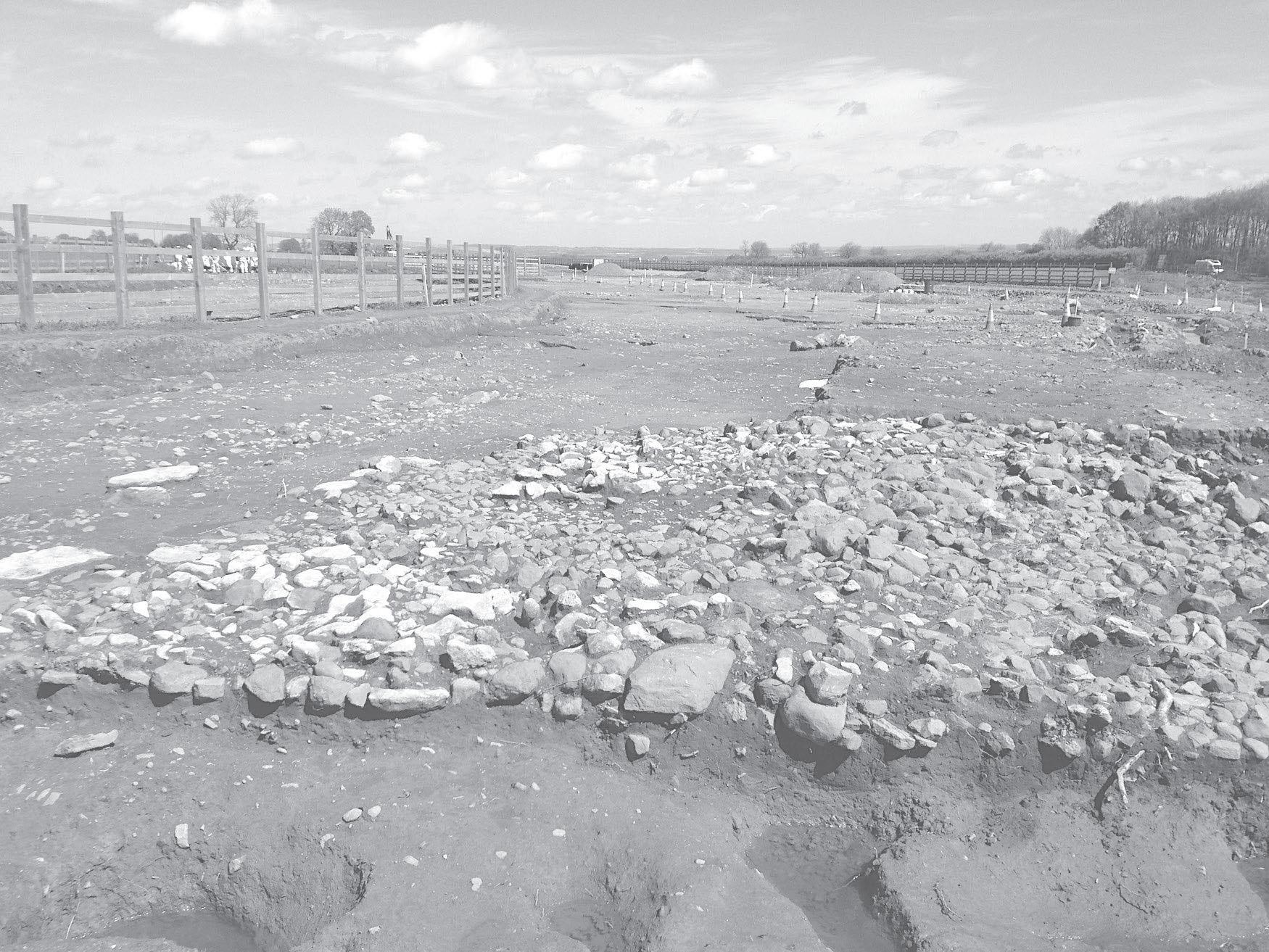
ensuring it didn’t interfere with the plans of the present. But with Highways England bankrolling every penny, you got the sense that the future was the overriding imperative. The road won’t wait too long for anything, even its own dead.
Steve continued: ‘As I said, time is of the essence. Something like the cemetery discovery is a challenge because archaeologists and diggers are in such short supply in Britain. Even with volunteer excavators and bringing in teams from Europe, we still don’t have enough people. Now that’s something we could do with you reporting on . . .’
Taking the hint, I rummaged for my notebook in the rucksack, scattering its contents across my lap in the process. I’d forgotten about the builder’s trowel until it fell, tangled up in my jumper, on to the seat between us. Steve passed it back to me.
‘That’s right,’ he said. ‘You mentioned doing some digging before.’
This was half-true. When we’d talked on the phone, he’d asked whether I had any experience on excavations. I’d answered that I had pitched in a few years earlier when sent by a newspaper to cover a British Army-run dig on Salisbury Plain. What I hadn’t disclosed was that I’d only really emptied wheelbarrows and made sugary tea.
Then he said: ‘Why don’t you have a go while you’re here?’
‘Would that be OK ?’
‘Don’t see why not. We’re always glad of an extra pair of willing hands. I’ll introduce you to Jan. He can show you the ropes. He’ll keep an eye on you.’
A little further along the A1, at the road sign for Catterick, Steve indicated and turned off the highway. Flicking on the pickup’s amber roof lights, we bounced along a works track, south, beside the halfbuilt carriageways, pulling up at two yellow shipping containers that had been repurposed into a field office and a canteen. Beyond lay a large square of interlocking metal fencing, the kind that corrals an audience at a festival. Enclosed within was the open horizon, that bare earth, pockmarked with exposed graves. Fumbling for the handle as Steve killed the engine, I opened the door a little. The reek of fresh greenery under sun. The cold, damp-dirt waft of tombs.
‘You ready?’ Steve asked. I nodded and we pushed out, into the light.
I scraped and I stared and, at first, I didn’t see a skull. What I saw was the edge of a pebble. I filled the shovel, turned, emptied it, leaned in again, only now Jan was studying it more closely. Something in the irregularity of shape. Not a bump, as such. More a ridge. Something about the way the mud clung. ‘Wait,’ he said. Then he went off to fetch some kit, returning with what looked like a stack of white icecream tubs. But while he was gone, I did something you’re probably not supposed to do. I took off a glove, reached down and ran my finger along that ridge. A little jolt. The sudden realisation that our summoning spell had worked: soil and stone into spoil and bone.
Jan was soon confirming suspicions. Another body burial. One of nearly 300 graves and cremations that would eventually be unearthed at Bainesse. Then, without fuss or fanfare, he lay on his side, propped on an elbow, and began dessert-spooning the surrounding fill away, thinning the membrane of that thin place even further. I’m not sure what I thought would happen next. More action, I suppose. More drama, like in the films. Tents. Forensics. We forget that people
become, if not numbed, then conditioned to getting on with even extraordinary work. That what might seem profound to one person is, to another, just one more job on a day’s long to-do list.
As he worked, Jan scooped various samples of spoil into the icecream tubs, marking them for closer inspection. Early analysis from other graves had yielded microscopic revelations, traces of sweetscented bedstraw and bog bean buried with the bodies. Such discoveries can be doorways into wider environmental information as well as revealing details, such as the month of burial. They explain too why ‘preservation in situ’ is the favoured archaeological methodology of today. The intent is to leave sites undisturbed unless they’re at real risk of being damaged or destroyed, and even then – where possible – to preserve artefacts in the place they’re found. The belief is that context will play a more important role in years to come; that our descendants will grimace at stripping and removal of sites in the way we do at heavy-handed eighteenth-century excavators. Technology will render locations increasingly significant, infused with decodable data. The implication being that we ghost the soil in deeper ways than we yet comprehend. That the earth is striated with our stories.
The ridge revealed itself to be part of the temporal bones of a human skull, lying sideways in the earth. That rise you can feel running back from your cheekbone towards your ear. Around it, surfaced the unmistakable curve of a cranium coated in fine clay, like brown vernix. Working quickly, Jan began to pick and brush what had been the bones of a face into being: an edge of an eye socket, a grinning jaw, unhinged, slack, as though the skull had been screaming for all its worth into the soil.
Around us, people appeared and disappeared. They’d be there one minute, in silhouette, gone the next, back into the ground. Occasionally, other diggers ambled over from their graves to have a ‘nosy’. The woman with the pink hair was halfway through digging her own body out of the ground. That was the way she described it, with all the oddness of that phrasing. Notes were taken, measurements, photographs. Time was of the essence, yes, but there was also a strict process to be observed. For all the mind-blowing implication of the work, archaeology is really concerned with the details. It’s about accurate data sets that can stand up to and inform scrutiny and research for
decades to come. So, I kept myself out of the way, crouching at the edge of the grave scrape, leaving Jan to swiftly, skilfully, coax the past back into present.
Once a halo of space had been cleared, it was possible to see how the skull had shifted in the grave over the centuries, slipping back on itself a little, like it was glancing over its shoulder. It gave the uncanny appearance of turning away, as if straining to escape the light falling over it for the first time in two millennia. Together with that silent, mid-scream mouth, it made me think for a moment of the way a teenager rolls their head back into a pillow in protest when the bedroom curtains are flung open. Funny , I told myself. But I wasn’t fooling anyone. There was nothing funny about it. On the contrary, in fact: it was becoming more unnerving and unsettling by the minute.
Thud-thud. Thunder behind and beneath. Felt as much as heard. Louder even than the traffic. At the edge of the site, two pile-drivers had been fired into life and were set on shoring up a half-constructed
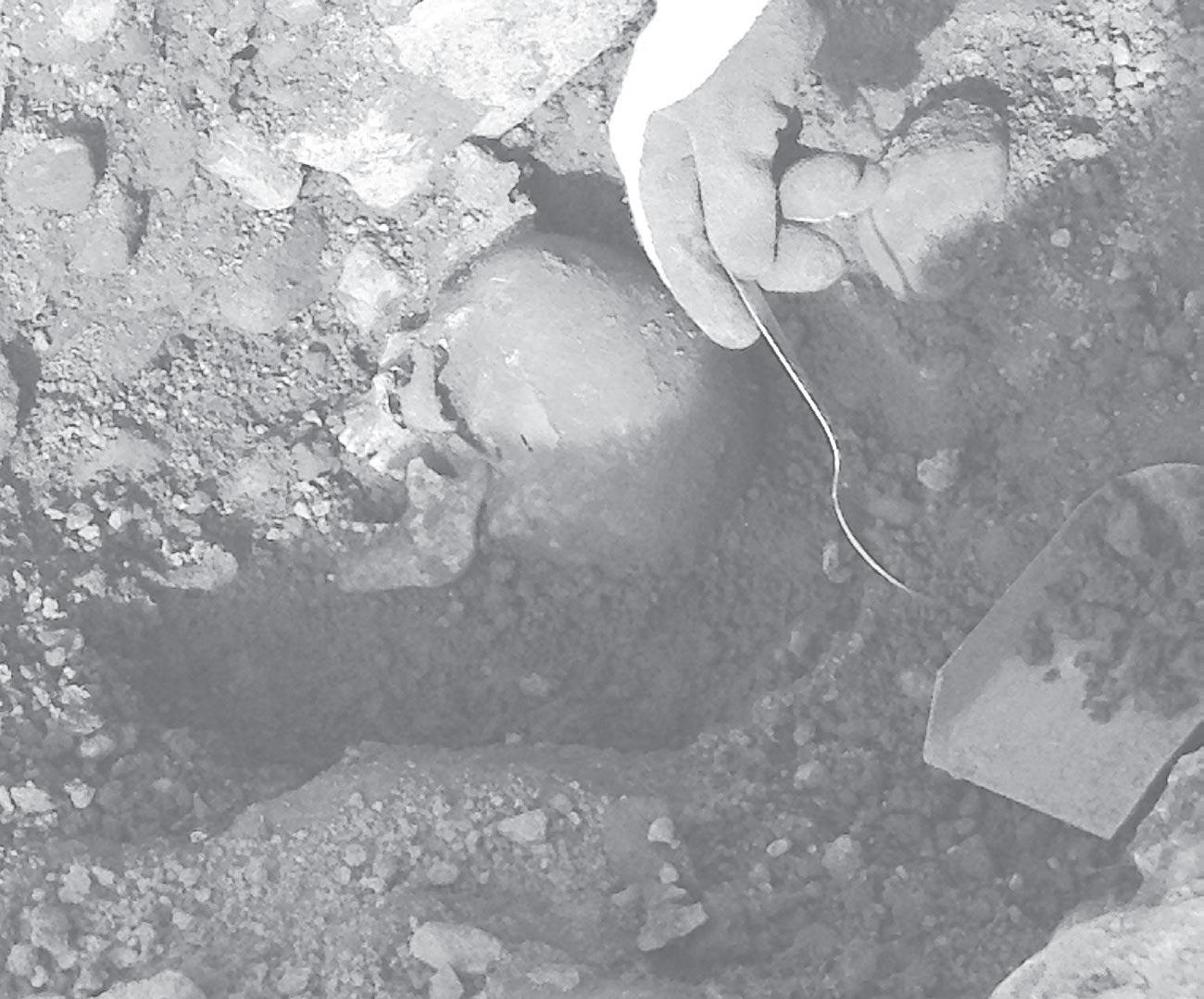
overbridge that would straddle the new motorway. Great pendulumlooking things with wasp heads, they struck in succession, slamming rods into the ground. Thud-thud, in twos, reverberating in the earth, like a heartbeat. Then a high whine as they reset – that first lungful of air after diving too deep.
The head was one end of the grave. Now for the other. Jan shifted position and began to expose the area around the legs, working down towards where he guessed the feet would be. The feet. After a while he was confident of the position of the skeleton: the leg bones straight and parallel. The body, he determined, had been placed flat on its back, arms by its side. The way you lie on a bed when testing a mattress.
‘See now,’ he said, brushing a tibia. ‘I guess a male. See how long they are?’
See indeed. I reminded myself that was the point of the exercise: to let the eyes adjust and see beyond the surface of things; to see now because who knows when you might get to see in such a way again? But for one so unused to death, seeing was also disbelieving. A too-severe shift in perspective. Here, the black mirror. Here, the skull under the skin of land. I understood then why they put fences around sites like these. Not only to keep out, but to keep in. To protect us oblivious passing by in our cars from catching sight of what we all know, but what we spend our days trying to forget. I knew too that I was getting out of my depth, but I couldn’t tear myself away. That’s the thing. Once you start to see like this, you can’t easily stop.
Thud-thud. The heartbeat in the ground. The earth stirred, and stirring.
What happened next felt like being lifted by a wave. A swelling unsteadiness brought on by all the strangeness of that morning. Blame it on looking down for too long or a thin skin from too many nights with too little sleep, but I was struggling to hold on to anything familiar, struggling to process the enormity of what was in front of me. It wasn’t just proximity of the emerging skeleton, but what it represented. The simultaneous flashing back and forward. The mind isn’t accustomed to reality destabilising in real-time, to streams of time spilling into one another and scenes, aeons apart, coexisting in the
same frame. Yet this was the sensation kneeling there between the future echoes of overbridges and those Roman bones. The world altered; all usual borders and barriers gone. There was the noise and frenzy of the present, the pile-drivers and the cars flowing by, windscreens exploding with sun, the drone of tyres on tarmac, that sour, throat-catch stink of warm diesel, yet there was the sense of another dimension too. No less present; no less tangible: a body being placed in a plain of sky and pasture, where the flashes tracering past weren’t sun on glass but stray sparks from pine fires borne on a breeze. Where the drone wasn’t road noise but prayer to unknown gods in a foreign tongue. Where the oil in the air was the incense of ritual offerings. Where we weren’t diggers at all, but mourners, laying flowers in a grave, reaching in to turn the face of a friend towards the distant moors and rising sun.
A few seconds, that’s all. That sensation rose and passed like a shiver. Time slipped back into its usual rhythms. The machinery cut out as abruptly as it had begun. The echoes faded. Before long one of the other diggers was petitioning for lunch: ‘Hey! It’s nearly two!’
Another yelled ‘I need cake ’ in mock desperation. Everyone laughed, then drifted from their graves towards the shipping containers.
Jan was standing too, pocketing the dessert spoon, sealing up the ice-cream boxes. ‘Time to go,’ he said, shielding his eyes from the skyglare. I followed the direction of his gaze and saw a Highways England pickup parked at the field’s edge. In the driver’s seat was Steve. Window down. Shades on. A phone clamped to his ear.
‘You see what you need,’ Jan said.
Only after he repeated it did I realise it was a question.
‘Oh, yes. I did. Thank you.’
A shrug. ‘Good.’ A grin. ‘Maybe take a photo too, if you want.’
And that was that. We shook hands and he was off in search of sandwiches. I stayed for a while, my shadow shrouding the skeleton, trying to take pictures on my phone. But there are things a camera can’t capture, things that nevertheless fix in the memory and fix for good. Doors you push through that can’t be closed again. That was the feeling as I stood there – the sense of something that couldn’t be framed in a shot: something to do with the open horizon and the open grave, something in that confluence of the old road and the new, and
of times intersecting. What I can tell you is this: when I turned and walked away, that feeling followed me.
*
In the afternoon Steve drove us from place to place on a tour of the other excavation sites. We were back on the A1, back amid the familiarity and the mundanity of traffic, humming along its smooth tarmac past Eddie Stobart lorries and service stations boarded with fast-food adverts and petrol prices. All of it felt different now. Oddly augmented. Under-shadowed. Wherever we went, it only seemed to sharpen this awareness of the rift below the asphalt. The aggregate beneath the aggregate.
Up where the A1 crosses the River Swale, at the site of the Roman fort of Cataractonium, a crew was upgrading the road bridge. New metal beams spanned the river on concrete pillars surrounded by scaffold. As Steve chatted with the team, I watched the water muscling past, peat-stained, creased with undercurrents. Then Steve waved me over. A flank of the southern bank had been stripped away and a section of the Roman fort wall was now visible as a seam of solid stone in the strata.
It’s believed the etymology of Catterick is bound up with the Swale, with the Latin cataracta translating as ‘waterfall’ or ‘lively river’. No one knows for sure, though, because it’s a word that also means ‘portcullis’, as in obstruction, like the cataracts of the eye. It’s possible too it derives from a Brythonic word meaning ‘battle ramparts’ and that the Romans simply co-opted it when they grabbed the land. They certainly had form in such assimilation. Words, cultural practices, even deities were lifted from areas they annexed and made their own. Gods of place, genius loci, adopted and appeased by those working the outlying borders of empire as they found themselves in alien locations. One stone altar, uncovered in a previous dig at Catterick, was dedicated to Veteris, a British god worshipped in the north and said to have been especially popular with legionaries stationed around Hadrian’s Wall.
‘There was another interesting altar discovered here a while back,’ Steve said, as we climbed into the pickup and buckled ourselves in.
‘It’s the only one, I think, ever been found to have been inscribed to the god who devised pathways and roads.’
‘Wait. The god of roads?’
‘I know,’ Steve said, chuckling. ‘Right here by the A1. God of roads itself.’
Driving up and down the highway, we stopped to visit teams that had called-in that morning with questions or discoveries. In one field office, archaeologists were analysing a tray of pot fragments. Pinned on the walls around them were hand-drawn identification guides and sketches of finds. Lists of Samian-ware stamps revealed not only the names of individual makers – Sacrillus, Masclinus – but also the location of the Gaulish kiln sites where the bowls and plates had been fired. There were colour-pencil renditions of a motto beaker, an alehouse drinking cup emblazoned with a slogan, LIFE IS GOOD, as well as depictions of bits of Nene Valley ware. This type of Britishmade pottery was transported up the road from mass-production facilities located at Durobrivae, a once-large Roman town 150 miles to the south that, today, lies buried under fields slap-bang next to the A1 at Water Newton.
At another location we opened the doors to a shipping container to find shelved units filled with bubble-wrapped objects ready to be moved off-site to museum storage. Steve peeled open oil lamps, an altar, a statue pitted and worn with age, masonry. In a corner was a hefty stone block. Thought to have been part of a doorway or arch, it had been chiselled in such a way as to leave a good-luck sign: a large phallus standing proud as schoolboy graffiti. As we walked outside again, the sudden whine and clunk of a lorry passing on the highway made me turn. Along its side, finger-drawn into a layer of dirt, someone had carefully traced the same shape.
Time was soon pressing; thin, sharp light starting to thicken as the sun arced westward. But there was one last place to go. We took a byway with enough of a gradient to provide a viewpoint across the Vale of Mowbray, pulling up at a fence that slumped into the grass to reveal a panorama of the plateau beyond. A fitting elevation to
appreciate the road. It lay there looking at once like a complete thing and a multiplicity unravelled, like when a cable gets twisted too many times and frays open, and you glimpse the wires within. You could see, in the distance, where it formed a single highway and where it split into constituent parts: where a ribbon of old coach road threaded off into Catterick, where the arrow-straight 1950s bypass continued along the course of its Roman ancestor and where the new loop of half-constructed motorway was manifesting in the fields. With the windows down and the engine off, you could hear it too. A distant inhaling and exhaling of passing cars, like breathing.
I asked Steve questions, clarified points and tried to remember things I’d meant to bring up. In between scribbling notes, I bit at my nails absentmindedly, forgetting about the dark, half-smile of dirt embedded under each cuticle, realising too late that the grit between my teeth and tongue was grave soil. Then we were off again, back down to the highway, back to that shining line leading everywhere.
II
In the weeks after the dig, I couldn’t stop thinking about the road. Our home was no less chaotic, the rollercoaster of parenthood no less precipitous, ecstatic, wearying; sleep was still, for the most part, a virtual concept only enjoyed by others. But I’d followed the road awhile, seen where it led, and something about it wouldn’t leave me alone. That double vision of the opened highway and the body in the earth lingered, like some vital words I’d forgotten to say. It would have been easy to dismiss the feeling as imagination running wild, but, in honesty, it felt like the opposite – like a sharpening of the senses. A glimpse through a rent in the fabric at something real.
I scratched at that feeling it left in me as you do a mosquito bite. May went about its business. Storms blew through and the air warmed. The world threw wide its windows. Squares of light slipped across the library walls as I searched its corners for any reference to the A1 or the Great North Road I could find. At home, I scoured the internet, buying and piling up out-of-print books on my desk. Books from the 1800s and the turn of the century; books from the 1950s and the 1970s. Books by Frank Morley, Norman Webster and C. G. Harper, all of which bore the weight and mystery of that title: The Great North Road. Obscure books on the old mail routes and the coaching age, on early maps and Roman roads. Books by the likes of Ivan Margary and Jessie Mothersole. Novels by Dickens and Walter Scott, such as The Heart of Midlothian in which his heroine, Jeanie Deans, tramps the road from Edinburgh to London in the 1770s. I turned up sixteenth-century diary entries and essays in parish newsletters; archived reports on highway accidents and magazine stories mockingly measuring the A1 against the so-called ‘epic’ drives of the
world, framing the road as a barometer of British decline. Reading, researching and replaying the events of that day in my head, I often found myself wandering, and wondering: What else did the road have to show? What else was out there waiting to be revealed?
One night, after we’d wrestled the kids into bed and the dishes were washed and stacked to dry, I sat up late in front of my laptop, located our terrace on Google Maps and then scrolled off towards the A1 again, retracing my steps via its assemblage of satellite images. Zoomed in, the pixelated shots of summer fields, houses and highway resembled a Hockney photo collage. There were no signs of the construction works; the photos must have dated from an August a year or two before, but as I clicked the cursor and dragged north towards where I estimated Bainesse must be, something odd occurred. The grey line of the current road was clear; its coloured-dot cars and lorries frozen mid-flow, casting shadows. Yet, on either side, the satellites had captured a perspective impossible to see on the ground. In the crops edging the road, underlayers: the watermark patterns of what appeared to be paths, tracks and structures traced in the barley and wheat. Doughnut-shaped enclosures, circles, and shaky, parallel lines. Weirdest, though, was what else was visible. The new A1(M), with its roundabouts and slip roads, was already mapped out as an overlayer, ribboning through the fields in thick, opaque-white lines. As I clicked and scrolled, this virtual road moved with me, fading, reappearing. I tried flicking on to ‘Street View’, curious to see what future vision it might transport me to, but in the hard descent to the tarmac it vanished, depositing me in the slow lane on the current A1, crawling along behind a white van. When I zoomed out again, it was back. A glitch, but one that seemed to confirm what I already knew: that I’d been viewing this highway all wrong. There, on the screen, the road was disclosing a truer nature again. A convergence of what was, what is and what will be; a muddy river of history far deeper than it is wide. A timeline running through the land.
*
Imagine, for a moment, a topographical map of Great Britain. Place a finger on London, then draw a line north to Edinburgh avoiding
major hills and mountains and you’ll be tracing a road. An old road and the country’s longest. A remarkable road with its roots in time out of mind; one that, in places, traces tracks laid down as far back as the Mesolithic. A road that, today, connects two nations and links eighteen counties, including the largest and smallest in England. A road bookended by frenzied capitals, that stitches together sprawling cities and suburbs, satellite developments and rural backwaters. A road that cuts along coastlines and through fields and flatlands, between once-grand towns and deserted villages, over lost graveyards and under new supermarket car parks. While not, perhaps, Britain’s oldest, this haunted and haunting assemblage of prehistoric desire path, ancient trackway, Roman road, pilgrim route, turnpike, coach road, A-road and motorway has surely been its most influential and important. A driving force, facilitator and fulcrum in the long story of these shores – and at times, by extension, the world – for the last 2,000 years and counting.
Now imagine closing in on that map, stepping into it. Imagine its earliest origins around you. See meandering tracks weaving through post-tundra woodlands. See them widening and deepening. See their significance increasing as our species, conversely, shifts to sedentism. See societies forming; agriculture, farming, the creation of myth and ritual. See settlement and segmentation. See stockpiles and surpluses. See new lines being drawn over old in the name of trade and exchange. See the swift arrival of their twins: possession and war. See tracks being forcibly conjoined, straightened, widened, heightened into a long power line laid out in stone. See it carrying emperors and the enslaved, connecting forts and fledgling cities. See it named, numbered and known across the seas. See it scarred and etched with the countless footprints of the unremembered as centuries wash over it. See it regreening, flooding, overgrowing. See it surfacing and echoing again with foot and hoof and wheel. See it spreading the word of God, kings and revolutionaries burning with their righteous ideals. See it bringing battle, plague, death. See it delivering untold freedoms and subjugations. See the mass movement of people, driven by desperation and by desire. See it pumping lifeblood throughout this land, becoming the major artery of a nation again, blueprinting future patterns of flow and commerce, spinning the wheels of mass production
and industry. See it empowering and arming an empire once more, enabling the export of unchecked human ambition and the want of things beyond limits across oceans and into new worlds. See all of this, and you will never look at this highway the same way again. See now. Jan had instructed me beside the road. Well, between those bones and the pages of the books on my desk, I was starting to see. Further, deeper. Starting to see this constantly seen and yet unseen thing. I was starting to comprehend its significance and scale for what they are. Here: a seam of collective memory still whirring away, still recording, still assembling the evidence. Zoom in or zoom out, the conclusion is the same. The road was never just another everywhereand-nowhere-land, an anonymous tarmac conveyor belt in the grim, grey web of infrastructure necessary for our survival. Here was an entity in its own right. A1: Alpha One. God of roads, indeed. Somewhere to be endured, but enduring. Something to be transcended, but maybe transcendent too.
There were warnings of getting too close. Not just in the old coachroad books with their tales of highwaymen and cut-throats, or in the wealth of evidence of the road’s dangerous pollution levels and crash death tallies, but stranger risks. In one newspaper story from 1997, I found the road described as ‘400 miles of death’. In the same feature, a lorry driver named Joe Doyle had been interviewed about his thirtyyear obsession with the A1. He explained that many haulage drivers chose the older north road even on journeys when the newer M1 provided a quicker, more direct route. Truckers felt ‘tied’ to it in ways they couldn’t enunciate. He confessed also that there were rituals reserved for this highway alone. Sequences of headlamp flashes, stopping places that only the initiated knew about. ‘The A1 is more than just a road,’ he admitted at the end. ‘It’s a disease. A disease you can’t get out of your blood.’
Somewhere along the line, amid all this discovery, I found I was writing again. As summer set out its stall and June arrived teeming with energy and expectation, the tank began replenishing itself. What had been blank screens started to fill with pages of typed-up notes. Dead
